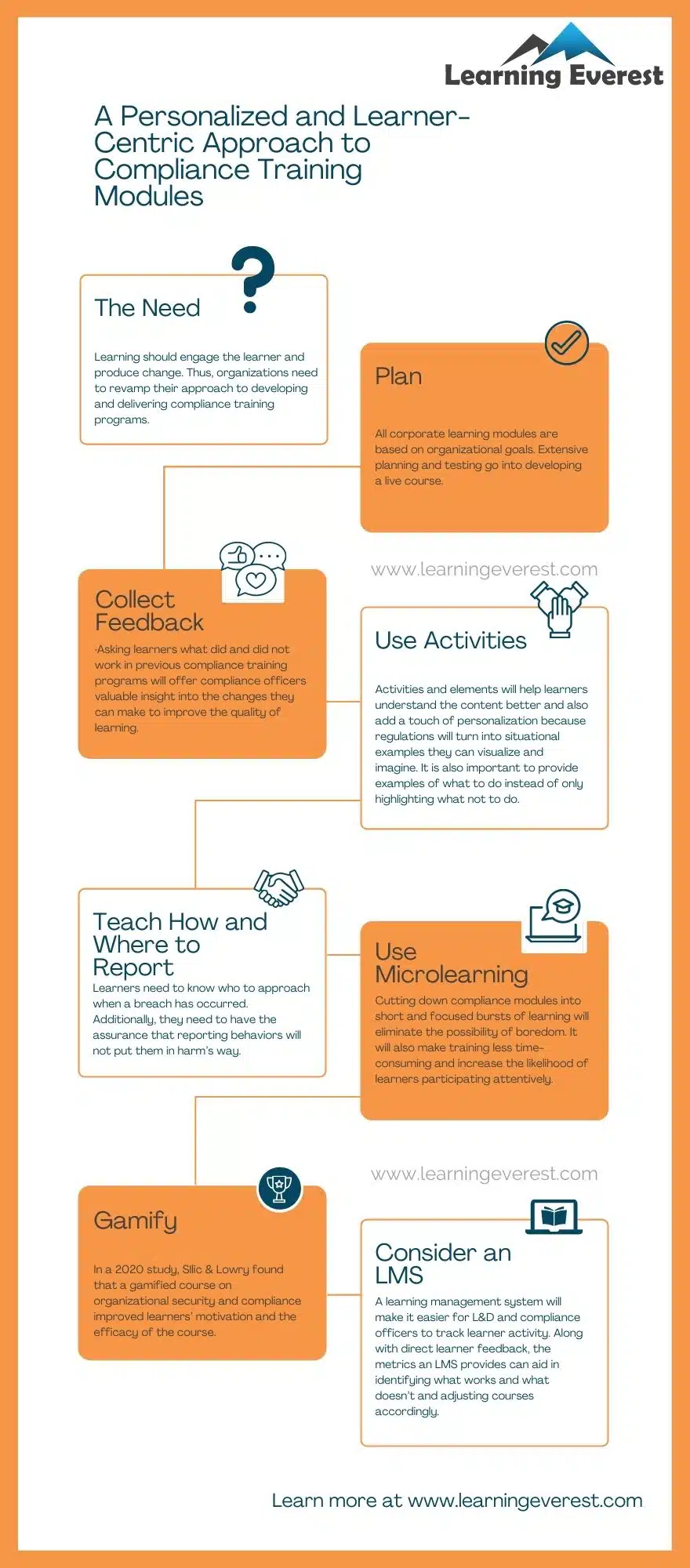Effective Compliance training is a necessary responsibility, organizations need to undertake to keep their businesses running. The practice originated in the United States between the 1970s and 80s and became a formal guideline by the 1990s. Eventually, the convention spread worldwide, making it the norm that it is today.
Table of Contents
According to Bloomberg, more than 50% of companies report spending 6-10% of their revenue on compliance. Such a high investment in a single training area only makes sense since the penalties for misconduct are severe. For instance, the fine for breaching the GDPR’s statutes can cost firms up to 4% of their worldwide yearly turnover or 20 million EUR, whichever is the highest. Along with that, the further losses incurred in the face of a scandal add to the repercussions.
Apart from preventing losses, though, compliance training also serves essential ethical, technical, safety, and cultural purposes. However, despite efforts that have spanned decades, compliance training is still not the tool companies and compliance departments want them to be.
Understanding Compliance Training
Compliance training relays the standards of conduct employees are expected to uphold during their tenure at an organization. These rules are a combination of legal and institutional regulations, industry standards, and company-specific behavioral requirements. Therefore, compliance programs typically have two distinct domains: corporate compliance and regulatory compliance.
Corporate compliance training ensures employees understand and follow the company’s internal policies and procedures.
On the other hand, regulatory compliance involves mandatory regulations set in place by legislative and governing bodies.
Features of Compliance Training
It has a few characteristics that set it apart from other forms of corporate training:
- It is mandatory: All employees are required to take compliance training, regardless of their department. On the other hand, other training programs might be optional or mandatory for only specific teams or departments.
- It is conducted periodically: Regulations and policies change constantly. Accordingly, compliance training occurs every 6-12 months to educate employees about updates, fixes, changes, and omissions.
- There is a deadline for completing the training: Employees don’t have the option to partake in compliance training as and when they choose, as completion rates are one of the most critical metrics for organizations to prove to authorities that they are abiding by regulatory standards.
Why Compliance Training is Necessary
Apart from keeping companies on regulatory bodies’ good side, compliance training has other significant benefits, such as:
- Ensuring employee safety – by educating them about safety protocols, power imbalances, sexual and physical harassment, bullying, etc.
- Fostering a culture of diversity and inclusivity – by promoting mutual respect and eliminating discrimination
- Ensuring consumer safety – through data security practices
- Maintaining a positive brand image and reputation in the eyes of customers and stakeholders – by establishing a uniform organizational culture that is reflected in how employees conduct themselves
- Preventing the company from getting into big lawsuits – by establishing internal disciplinary and grievance redressal procedures
- Preventing significant monetary losses – non-compliance comes at a high price, as illustrated in the GDPR’s example mentioned earlier. Diligent Insights states that the cost of non-compliance has increased by 45% since 2011. Furthermore, a single non-compliance incident can cost companies up to $4 million, according to a GlobalScape report.
But despite everything, there still remains a significant gap in organizations’ and employees’ perceptions of compliance training.
Is Compliance Training Effective?
The short answer is no. A vast majority of employees do not have a very genial view of compliance training.
According to a Gallup study, corporate learners have the following opinions about the compliance training they have received:
- Only 1 in every 4 people surveyed rate the training as “excellent”
- Only 10% of employees have observed a visible change in their coworkers’ and their own behavior after training
- Web-based compliance training fares the worst when it comes to delivery
However, this investigation also revealed a more instructive insight, that is, 84% of employees who thought the training they received was “excellent” also agreed that they felt equipped to report or raise concerns about non-compliance after the training. Additionally, 72% of these employees also agreed that their organization had a culture that supported speaking up.
An Elucidat survey also had very similar findings. In a sample of financial service employees, 44% did not feel confident that compliance training equipped them with the means to protect themselves or the organization.
Thus, one of the main blind spots of compliance training right now is teaching employees the HOW of compliant behavior. In the L&D sphere, it is a well-established fact that effective learning produces a tangible behavioral or cognitive change in the learner. Current compliance training norms do not fulfill this requirement.
At the same time, Elucidat also reports that employees find the delivery of such courses boring. 15% click through the content without reading and 34% only skim.
Another pitfall of compliance training is that organizations often fail to track incidents of non-compliance. According to Deloitte, 90-95% of companies measure training effectiveness primarily by calculating completion rates. Thus, there are no metrics to gauge effectiveness and quality.
The Solution: A More Personalized and Learning-Centric Approach
Learning should engage the learner and produce change. Thus, organizations need to revamp their approach to developing and delivering compliance training programs.
The principles that apply to e-learning course design can, thus, be used in compliance training as well. Any instruction must feel relevant and meaningful to the learner to retain it. E-learning offers many innovative tools and opportunities to fulfill these cases.
Some tips to improve compliance training courses are:
- Start with a plan – all corporate learning modules are based on organizational goals. Extensive planning and testing go into developing a live course. Frameworks and guidelines like the ADDIE learning model, Kirkpatrick Training Effectiveness Model, Bloom’s Taxonomy, etc. inform the process.
- Collect learner feedback – asking learners what did and did not work in previous compliance training programs will offer compliance officers valuable insight into the changes they can make to improve the quality of learning.
- Use case studies, scenarios, stories, and roleplays – such activities and elements will help learners understand the content better and also add a touch of personalization because regulations will turn into situational examples they can visualize and imagine. It is also important to provide examples of what to do instead of only highlighting what not to do.
- Provide clear instructions for reporting non-compliance – learners need to know who to approach when a breach has occurred. Additionally, they need to have the assurance that reporting behaviors will not put them in harm’s way.
- Use microlearning – cutting down compliance modules into short and focused bursts of learning will eliminate the possibility of boredom. It will also make training less time-consuming and increase the likelihood of learners participating attentively.
- Gamify the course to increase motivation – Gamification is a very widely used tool in e-learning and there’s no reason why it will not apply to compliance training, as well. In a 2020 study, SIlic & Lowry found that a gamified course on organizational security and compliance improved learners’ motivation and the efficacy of the course.
- Use an LMS – a learning management system will make it easier for L&D and compliance officers to track learner activity. Along with direct learner feedback, the metrics an LMS provides can aid in identifying what works and what doesn’t and adjusting courses accordingly.
Thus, organizations will benefit from having more fun with their compliance training approach to spruce things up for their learners. There is no reason for compliance to be boring, and given the high stakes non-compliance has, it should be treated to produce maximum efficiency.
Infographics
Frequently Asked Questions (FAQs)
What is compliance training?
Compliance training relays the standards of conduct employees are expected to uphold during their tenure at an organization. These rules are a combination of legal and institutional regulations, industry standards, and company-specific behavioral requirements.
How do I start a compliance training program?
Start with a plan, collect learner feedback, use case studies, scenarios, and stories, provide clear instructions for reporting non-compliance, and use e-learning tools like microlearning, gamification, and a good LMS.
Why do we need compliance training?
Compliance training is important because it ensures:
- Employee safety
- Fosters diversity and inclusion
- Ensures customer safety
- Maintains brand image and reputation
- Prevents lawsuits and monetary losses
What should be included in compliance training?
Compliance programs typically have two distinct domains: corporate compliance and regulatory compliance. Corporate compliance training ensures employees understand and follow the company’s internal policies and procedures. On the other hand, regulatory compliance involves mandatory regulations set in place by legislative and governing bodies.






